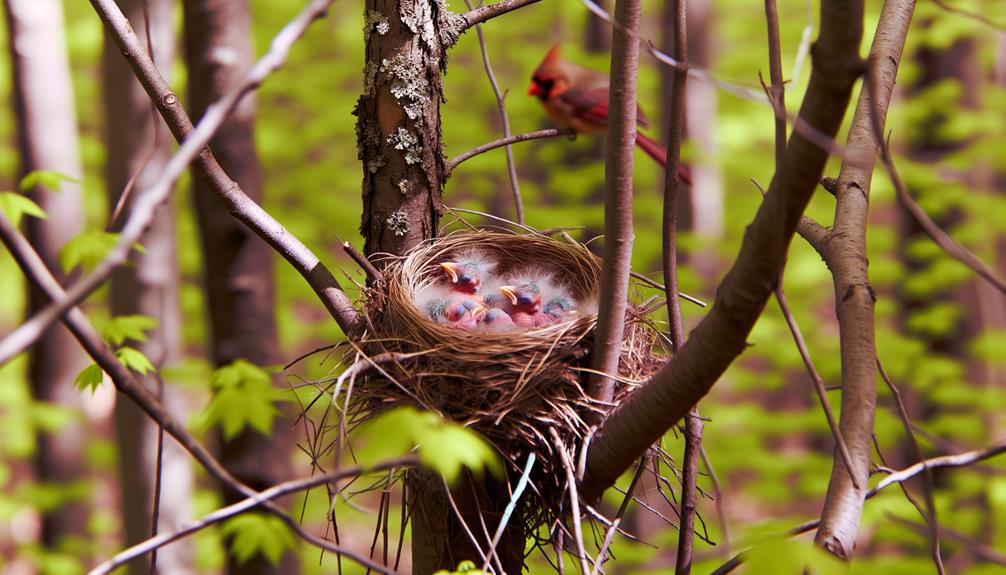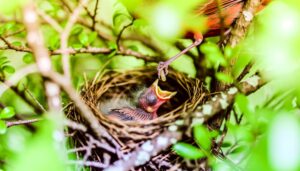How to Determine the Age When Baby Cardinals Leave the Nest
Baby cardinals typically leave the nest about 10 to 12 days after hatching. They're altricial, meaning they're entirely dependent on their parents initially.
Around day 3 to 5, their eyes open, and by day 7, pin feathers emerge. Their motor skills improve substantially within the first week.
Around day 10, they respond to external stimuli and begin practicing flight. Both parents play pivotal roles in feeding and protecting them, ensuring a balanced diet for rapid growth.
Fledglings gradually spend more time away, honing essential survival skills. Continue to explore how parental care enhances their independence and chances of survival.

Key Takeaways
- Baby cardinals typically leave the nest around 10-11 days after hatching.
- Fledglings start practicing flight and foraging skills as they leave the nest.
- Parental care continues even after fledglings leave the nest for gradual independence.
- Both parents feed and protect fledglings during their early days outside the nest.
- Fledglings become fully independent several weeks after leaving the nest.
Cardinal Nesting Habits
Cardinals exhibit meticulous nesting habits, often choosing dense shrubbery or low trees to construct their well-hidden nests. You'll find that they prefer areas with thick foliage offering protection from predators.
Females typically build the nests, utilizing materials like twigs, leaves, grass, and bark. Their nests are usually cup-shaped and can be located 1-15 feet off the ground. Research indicates cardinals can take about 3-9 days to complete their nests, ensuring they're sturdy and secure.
Observations show that cardinals are highly selective about nest site location, often opting for spots with the best cover and minimal disturbances. This careful nesting strategy is essential for the survival of their offspring, providing a safe environment for the chicks' early development stages.
Egg Incubation Period
You'll find that the egg incubation period for cardinals typically spans 11 to 13 days. During this time, the female primarily assumes the responsibility of keeping the eggs warm, while the male provides food and protection.
Studies indicate that consistent incubation temperature is essential for the successful development of the embryos.
Duration of Incubation
Observing the egg incubation period, you'll find that it typically lasts around 11 to 13 days. During this time, the cardinal eggs are kept at a constant temperature, which is essential for embryo development. The female cardinal mainly handles incubation, ensuring the eggs receive consistent warmth and protection.
Here's a quick reference table for cardinal egg incubation:
| Day | Activity | Observation Notes |
|---|---|---|
| 1-3 | Egg laying completes | Female begins incubation |
| 4-6 | Steady incubation | Minimal disturbance, constant warmth |
| 7-9 | Embryo development | Increased nutrient absorption |
| 10-12 | Final growth phase | Visible movement within the egg |
| 13 | Hatching begins | Chicks start breaking the shell |
This period is vital for the survival and proper development of the baby cardinals.
Parental Roles Explained
Throughout the incubation period, the female cardinal remains dedicated to maintaining ideal conditions for the eggs, while the male supports by foraging and protecting the nest. You'll notice the female spends most of her time on the nest, ensuring a consistent temperature around 100°F (37.8°C). She meticulously adjusts her position to evenly distribute warmth.
Meanwhile, the male's role is essential; he gathers food and keeps potential predators at bay, ensuring the female can focus entirely on incubation. Research shows that this division of labor maximizes the chances of successful hatching. It's fascinating to observe how both parents share responsibilities, optimizing their reproductive success through these well-coordinated efforts.
This teamwork is crucial for the survival of the species.
Hatchling Development Stages
In the early stages of a hatchling cardinal's development, meticulous observations reveal that the chicks are altricial, meaning they hatch blind, featherless, and entirely dependent on their parents for survival. Initially, you'll notice their eyes remain closed for about 3-5 days. During this period, their primary focus is on growth and gaining strength.
By the end of the first week, you'll observe pin feathers beginning to emerge, offering some insulation. Motor skills start developing around this time, allowing limited movements. By day 10, you'll clearly see the chicks opening their eyes and responding to environmental stimuli.
These stages are critical as they set the foundation for further development, leading up to their eventual fledging.
Parental Feeding Roles
Both male and female cardinals actively participate in feeding their chicks, ensuring they receive a diet rich in protein and essential nutrients. You'll notice that the male often sources food while the female stays close to the nest. This division of labor enhances the survival rate of the young. Research indicates that their diet primarily consists of insects, which are crucial for growth. Observations show that parents make frequent feeding trips, averaging several times an hour.
| Role | Activity |
|---|---|
| Male | Sourcing insects and seeds |
| Female | Providing food at the nest |
| Both | Ensuring a balanced diet |
| Both | Protecting the nest |
| Both | Coordinating feeding schedules |
This teamwork maximizes efficiency and supports the rapid development of the chicks.
Growth Milestones
Cardinal chicks undergo rapid growth, with significant milestones observable within the first few weeks of life. You'll notice their eyes opening around day 5, a developmental stage of great importance.
By day 7, pin feathers emerge, providing necessary insulation. During this period, the chicks' growth rate accelerates, enabling them to double their body weight in just a few days.
By day 10, wing feathers begin unfurling, and their legs strengthen, preparing them for upcoming motor activities. Research shows that around day 12, they start exhibiting wing-flapping behaviors, a precursor to fledging.
Each milestone reflects intricate physiological changes, driven by high metabolic activity and parental care. These milestones are essential for the chicks' survival and eventual independence from the nest.
Fledgling Readiness Signs
As the chicks reach day 12, you can observe specific signs indicating their readiness for leaving the nest. One prominent sign is the development of substantial primary and secondary feathers, essential for flight.
You'll also notice increased wing flapping as they build muscle strength. In addition, their coordination improves, allowing them to perch more steadily within the nest.
Behavioral changes, such as heightened alertness and responsiveness to external stimuli, become evident. Moreover, fledglings start vocalizing more frequently, a sign of social interaction skills.
Studies show that these indicators collectively signify their physical and neurological readiness to shift from nest-bound to fledging. Monitoring these signs helps you ascertain their developmental stage accurately.
Leaving the Nest
You'll observe that baby cardinals typically leave the nest approximately 9-11 days after hatching. Research indicates that during this fledging process, they rely heavily on parental guidance.
Post-fledging parental care extends for about 3-4 weeks, ensuring the fledglings' survival and adaptation to their environment.
Fledging Process Overview
Observing the fledging process reveals that baby cardinals typically leave the nest approximately 10 to 12 days after hatching. During this vital period, you'll notice the nestlings rapidly developing feathers and motor skills necessary for survival. They begin to exercise their wings, preparing for short flights. By day 10, most exhibit increased activity and readiness to leave the nest.
| Day | Development Milestone |
|---|---|
| 1 | Hatching, eyes closed |
| 3 | Eyes start to open |
| 5 | Feather development begins |
| 8 | Wing flapping and stretching |
| 10-12 | Fledging occurs, leaving nest |
Cardinal nestlings rely on instinct and practice as they venture out, exploring the world beyond their initial sanctuary. Your observations will be essential in understanding their independence journey.
Parental Guidance Duration
Parental guidance for fledgling cardinals typically extends for several weeks post-fledging, during which the adult birds provide essential support and teach necessary survival skills.
During this pivotal period, both male and female cardinals actively participate in feeding the fledglings, ensuring they receive adequate nutrition to support growth.
Observations indicate that parents also demonstrate foraging techniques and alert their young to potential predators, enhancing the fledglings' survival rate.
Research reveals that the parental care phase is vital for the fledglings' development of independence and self-sufficiency.
You'll notice that as the weeks progress, fledglings gradually spend more time away from their parents, practicing flight and honing their foraging skills, until they're fully capable of surviving on their own.
Supporting Young Cardinals
Providing sufficient support for young cardinals involves guaranteeing they've access to appropriate food sources and secure habitats. You should offer a variety of seeds, berries, and insects, as these make up their natural diet. Installing bird feeders with high-quality seed mixes can help.
Additionally, create a safe environment by planting dense shrubs or trees where young cardinals can find cover from predators. Water sources like birdbaths are also essential for hydration and hygiene. Regularly observe their behavior to make sure they're adapting well.
Research indicates that human intervention, such as minimizing disturbances and avoiding harmful pesticides, notably enhances their survival rates. By implementing these strategies, you'll contribute to the healthy development of these fledgling birds.
Conclusion
By understanding cardinal nesting habits and their meticulous parental care, you've now seen how these little birds grow from eggs to fledglings ready to conquer the world.
Within just a few weeks, baby cardinals transform from helpless hatchlings to adventurous young birds, practically bursting out of the nest like popcorn.
Observing their journey is like watching nature's most fascinating research project unfold right in your backyard.
So, keep an eye out and support these young avian adventurers!






